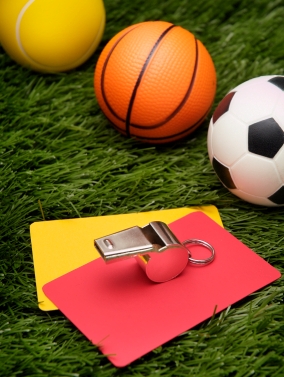Rules regarding player safety are well-defined with specific responsibilities for officials from the moment they take the floor. Pre-game requires officials to survey the playing area and request removal of equipment located near the playing area that poses a safety hazard.
Volleyball nets and gymnastic mats, for example, are often stored near the endline and could interfere with officials and players. During the game, officials warn teams for having water on the floor near the bench or playing area that puts player safety at risk. Further similar delay- of-game infractions result in technical fouls. Officials charge personal fouls for rough play, or flagrant fouls for violent or deliberately injurious plays, the latter resulting in immediate ejection of the player along with other penalties assessed the offending school and/or coach. These fouls usually result in an immediate stop in play.
Rules regarding the stoppage of play for the removal on an injured player are less clear. Laws in a majority of states now the immediate removal if player when an official observes a player displaying concussion signs or symptoms.
But what about players who are not concussed, but have fallen on the floor during the game, and are clearly in pain? What if a player loses his safety goggles or contacts during play? Many a sideline parent has yelled, "Hey ref, stop the game, a player is hurt!" And their frustration escalates for the several seconds that the game continues, with no immediate whistle to stop play.
Why don't officials stop play when a player goes down? The answer is the subject of disagreement between parents and officials: Unless a player is bleeding, unconscious, or at immediate risk of further injury due to proximity to other players, the official will stop the play only after a play finishes-- such as after a made or missed basket, or when there is clear opportunity to stop play without affecting possession. In other words, if a player goes down and the ensuing action moves the other players away from him/her, the official will keep his eye on the player, but allow the game to continue and the play to finish. There is no precise rule on this. It is a judgment call based on ensuring player safety for all the players on the court.
Some parents and coaches take matters into their own hands and come onto the court, without approval of the official, to attend to the player. Such reaction is ill-advised. Aside from meriting an immediate technical foul, unauthorized entry on the playing area can result in more personal injury to the parents as well as the other players on the court.
Players and coaches need to understand that officials are charged with maintaining player safety for all players on the court. Stopping the game at the appropriate time and managing unauthorized court entry are actions that game officials take to achieve this goal.
Barbara Bleiweis is a working mom, high school basketball official, youth sports advocate and writes the blog "The Patient Whistle" on MomsTeam. She lives in McLean, VA, raising two teenagers and two cats.








